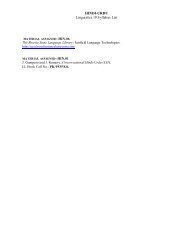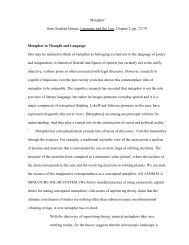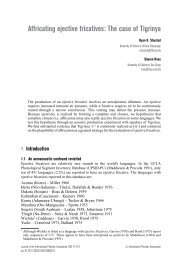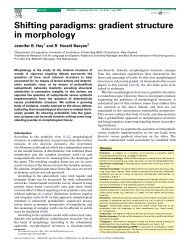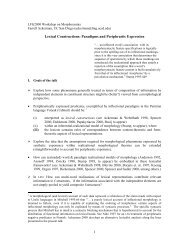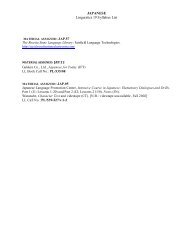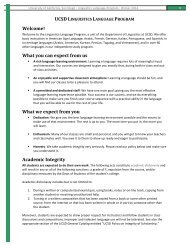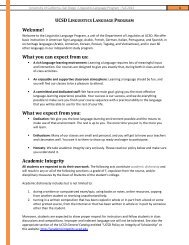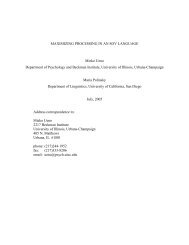1 Chaha (Gurage) Morphology Sharon Rose University ... - Linguistics
1 Chaha (Gurage) Morphology Sharon Rose University ... - Linguistics
1 Chaha (Gurage) Morphology Sharon Rose University ... - Linguistics
Create successful ePaper yourself
Turn your PDF publications into a flip-book with our unique Google optimized e-Paper software.
1. Introduction<br />
<strong>Chaha</strong> (<strong>Gurage</strong>) <strong>Morphology</strong> ∗<br />
<strong>Sharon</strong> <strong>Rose</strong><br />
<strong>University</strong> of California, San Diego<br />
<strong>Chaha</strong> (cha) is a <strong>Gurage</strong> dialect belonging to the Ethiopian branch of the Semitic<br />
language family. It is a member of the Western <strong>Gurage</strong> group of dialects along with<br />
Ezha, Gyeta, Endegegn and Inor. <strong>Chaha</strong> itself also has some sub-dialects, Gura and<br />
Gumer. The data for this article come from the dialect spoken in the main <strong>Chaha</strong> town of<br />
Endeber and neighboring villages, such as Yeseme. Endeber is located approximately<br />
180 kilometers south-west of Addis Ababa, the capital of Ethiopia. The 1994 census<br />
∗ Many thanks to Hailu Yacob and Tadesse Sefer for contributing data, and to Alan Kaye for editorial<br />
assistance. I am extremely grateful to Degif Petros Banksira for extensive comments on the article, leading<br />
to significant improvements. Errors are my responsibility.<br />
The following abbreviations are used: acc. = accusative; f = feminine; m = masculine; p = plural; s =<br />
singular; impf. = imperfect; pf. = perfect; juss. = jussive; conv. = converb; inf. = infinitive; impl. =<br />
impersonal; caus. = causative; neg. = negative; def.fut. = definite future; indef.fut. = indefinite future; O =<br />
object. Person, gender and number combinations such as 3fs correspond to subject marking unless<br />
otherwise indicated.<br />
Symbols are in accordance with IPA except for the palatal affricates, for which I use [c] and [j]. Note that<br />
the vowel I transcribe as [] is other authors’ (Leslau, Hetzron) [ä] and my [] is their [].<br />
1
divides the <strong>Gurage</strong> into three groups according to language: Soddo, Silte and Sebat Bet.<br />
Sebat Bet translates as ‘seven houses’ and is a linguistic-cultural term referring to the<br />
seven main groups of the Western <strong>Gurage</strong>. There were 621,691 Sebat Bet <strong>Gurage</strong><br />
speakers in the whole <strong>Gurage</strong> administrative zone in 1994 (1994 Population and Housing<br />
Census of Ethiopia); it is not known how many <strong>Chaha</strong> there are within this group. The<br />
number of Sebat Bet speakers for the <strong>Chaha</strong> Woreda, or administrative district, was<br />
114,970, most of whom can be assumed to be <strong>Chaha</strong> speakers. This figure, of course,<br />
does not include the large numbers of <strong>Chaha</strong> who live in other areas of the district and<br />
country, particularly Addis Ababa.<br />
2. Morphological typology<br />
The verbal system of <strong>Chaha</strong> is highly inflectional, with prefixes and suffixes<br />
indicating categories such as person, number, gender and tense. 1 Although the <strong>Gurage</strong><br />
dialects have been largely influenced by Cushitic (Leslau 1952), the verbal system<br />
nevertheless retains the characteristic Semitic root-and-pattern morphology, well-known<br />
from studies of Arabic, Hebrew or Tigrinya. The ‘root’, composed of consonants 2 ,<br />
conveys the core lexical semantics. The ‘pattern’ refers to the stem shape and stem<br />
vowels which correspond to different aspectual or tense categories. The<br />
1 Description of the morphology is presented in an item-and-arrangement model. Although standard<br />
practice, this model does pose certain problems with i) process alternations and ii) isomorphic form-<br />
meaning correspondences.<br />
2 There are some roots which have vocalic elements. See section 3.4.<br />
2
nominal/adjectival system has some vestiges of the root-and-pattern morphology, but is<br />
inflectionally impoverished; noun stems lack gender and number marking altogether. For<br />
example, there is no system of internal changes to indicate plurality (‘broken plurals’), as<br />
there are in other Semitic languages such as Arabic and Tigrinya. Notwithstanding, there<br />
are identifiable common roots between nouns, adjectives and verbs, as the following<br />
examples illustrate:<br />
(1)<br />
Root Verb 3 Noun/Adjective<br />
k’ms k’ms ‘he tasted’ k’m w s ‘tasty’<br />
k’rt’m k’rt’m ‘he cut into parts’ k’ w rc’m ‘splinters of wood’<br />
grz gnz ‘he aged’ g w rz ‘old’<br />
3<br />
grzna ‘old age’<br />
t’t’ t’t’ ‘he grabbed’ t’wac’ ‘handful’<br />
rr npr ‘live’ nrt ‘life’<br />
3 Verbs are given in the 3ms perfective citation form. <strong>Chaha</strong> perfective verbs end in a suffix –m in<br />
affirmative main clauses, which is usually shown in the citation form (Leslau 1979). I leave this off for<br />
simplicity.
<strong>Chaha</strong> (and other Western <strong>Gurage</strong> dialects) has undergone numerous<br />
morphophonological changes, which can render opaque the relationship between words<br />
formed from the same root. Characteristic changes illustrated above include labialization,<br />
palatalization, devoicing and sonorant alternations. Some of these alternations have also<br />
come to indicate, often in conjunction with other affixes, particular morphological<br />
categories. See section 5.7.<br />
3. Verbal stem morphology<br />
Ethiopian Semitic languages employ the root-and-pattern system of combining a<br />
consonantal root with vowels to form verb stems. The <strong>Chaha</strong> roots /mgr/ ‘suppurate’, /srf/<br />
‘be afraid’, /kft/ ‘open’ and /dr/ ‘add’ illustrate the verbal root-and-pattern system in the<br />
three main aspectual verb forms, perfective, imperfective and jussive. The medial root<br />
consonant is devoiced in the perfective form, or /r/ is hardened to [n]; we will return to<br />
this phenomenon in section 3.2.<br />
(2) ‘to suppurate’ ‘to be afraid’ ‘to open’ ‘to add’<br />
Perfective mkr- snf- kft- dpr-<br />
Imperfective j-mgr j-srf j-kft j-dr<br />
Jussive j-mgr j-srf j-kft j-dr<br />
4
The standard tri-consonantal perfective form is of the shape CCC, 4 where C stands for<br />
root consonant, and the imperfective is CC()C. The vowel [] is epenthetic - its<br />
occurrence throughout the language is largely predictable from syllable constraints<br />
(Banksira 2000a:25). The jussive has two main forms: CCC if the verb is intransitive, as<br />
with j-mgr, and if transitive, either CCC or CCC. The position of the epenthetic<br />
vowel depends on the quality of the second and third consonants (Leslau 1964, Banksira<br />
2000a, <strong>Rose</strong> 2000). The imperative has the same form as the jussive, minus subject<br />
agreement prefixes.<br />
3.1 Lexical verb types<br />
Triconsonantal verbs in Ethiopian Semitic are divided into lexical classes (Cohen<br />
1936, Leslau 1950). The forms illustrated in (1) are ‘Type A’ verbs. <strong>Chaha</strong> also has Type<br />
B, Type C, and a fourth type, Type D, not normally recognized in other Ethiopian<br />
Semitic languages. Type B verbs are characterized by a palatal consonant or a front<br />
vowel in the first vocalic position of the stem. This occurs in the perfective and<br />
imperfective positions, but not in the jussive.<br />
4 The only exception to this shape is if the second consonant is [n] and the final one is a coronal stop: fnt-<br />
‘cut in half’ or bnt’- ‘become wise’<br />
5
(3) Type B verbs<br />
‘finish’ ‘cut in big ‘to burn’ ‘to select’<br />
slice’<br />
Perfective jpr- g j nz- mk j r- met’r-<br />
Imperfective j-jpr j-g j nz j-mk j r j-met’r<br />
Jussive j-dpr/j-dr j-gnz j-mkr j-mt’r<br />
The initial consonant is palatalized if it is a coronal or velar obstruent, as shown in the<br />
first two verbs. The second consonant is palatalized only if the first consonant is a labial<br />
consonant or a coronal sonorant and the second one is velar, as with the verb mk j r.<br />
Otherwise, the front vowel [e] appears instead of [], as with mezr. Some authors claim<br />
that Type B verbs are not formed from triconsonantal roots, but are instead<br />
quadriconsonantal forms, the second consonant being the glide /j/, which is responsible<br />
for the palatalization and vowel fronting (<strong>Rose</strong> 1994b, Banksira 2000a). Leslau (1948)<br />
proposes that Type B had a historical CeCC or CeCC shape, with the /e/ triggering<br />
palatalization of relevant consonants. Hudson (1974) and Hetzron (1972, 1977) assume<br />
that palatalization is, in some manner, part of the underlying root. Unlike Type A verbs,<br />
Type B verbs usually show no alternation of the penultimate consonant. This is due to the<br />
fact that they have devoicing or hardening in all aspectual forms. However, some verbs<br />
optionally show devoicing in the jussive, as with the verb ‘finish’.<br />
6
Type C verbs are characterized by the vowel [a] in the first vocalic position in all<br />
aspectual forms, as shown in (4):<br />
(4) Type C verbs<br />
‘to capture’ ‘to demolish’ ‘to get lost’<br />
Perfective manx- banr- zapt-<br />
Imperfective j-manx j-banr j-zapt<br />
Jussive j-marx j-barr j-zapt/j-zat 5<br />
As with Type A verbs, the medial consonant alternates between between [p] and [], with<br />
the voiceless variant appearing in the perfective, imperfective and optionally in the<br />
jussive. The same pattern of alternation is found with [n] and [r], with [n] in the<br />
perfective and imperfective. These mutation patterns are found throughout the verb<br />
conjugations and will be discussed shortly in section 3.2.<br />
Type D is described by Petros (1993) and is similar to Type B, except the initial<br />
consonant is labialized. There are few members of this class; most verbs belong to either<br />
the Type A or Type B categories. The consonant [b w ] is realized as [w] in intervocalic<br />
position. Banksira (2000a) analyzes these verbs as quadriconsonantal, the second<br />
consonant being /w/.<br />
5 Both forms are attested.<br />
7
(5) Type D verbs<br />
‘to become strong’ ‘to feel lonely’<br />
Perfective k’ w mr- b w ns-<br />
Imperfective j-k’ w mr j-wns<br />
Jussive j-k’ w mr j-wrs<br />
Like Type B verbs, the jussive pattern is CCC. The same [n]/[r] alternation also appears<br />
in Type D, with the [n] appearing in the perfective and imperfective, and the [r] in the<br />
jussive.<br />
Due to the lexical conjugation patterns, it is possible to have homophonous<br />
triconsonantal roots that differ in their Type classification, ex. bnr- ‘fly’ (A),<br />
a-benr- ‘yawn’ (B) 6 or banr- ‘demolish’ (C).<br />
Quadriconsonantal verbs are also common in the language, and are conjugated as<br />
in (6). Alternation of the penultimate consonant (voiced/voiceless in the case of grtm)<br />
occurs in the perfective and imperfective.<br />
6 This verb has an obligatory prefix. See section 4.<br />
8
(6) Quadriconsonantal verbs<br />
‘to testify’ ‘break something in two’<br />
Perfective mskr- grtm-<br />
Imperfective j-mskr j-grtm<br />
Jussive j-mskr j-grdm<br />
3.2 Mutation pattern<br />
The system of consonant mutations are an integral component of the conjugation<br />
patterns differentiating the verb Types and aspectual forms. The consonant<br />
correspondences are shown below. I will refer to the voiced/x/r series as ‘weak’ and the<br />
voiceless/k/n series as ‘strong’.<br />
(7) Weak Strong<br />
/b w/b p p<br />
d j z t c s <br />
k k k<br />
x x x k k k<br />
r n<br />
9
The strong consonants are the hardened or devoiced versions of the weak<br />
correspondents. However, the voiceless consonants [t c s ] are not always devoiced<br />
variants of the voiced obstruents, and may simply be underlying voiceless obstruents, a<br />
situation which results in neutralization in the perfective stem. So, if a perfective form<br />
has a voiceless penultimate consonant, other verb forms must be examined to reveal<br />
whether the voicelessness is underlying or derived via devoicing. For example, btr ‘he<br />
was first’ has the root /bdr/ (imperfective: j-dr), whereas ktf ‘he chopped’ has the<br />
root /ktf/ (imperfective: j-ktf). The same problem does not arise for [n] and [p] which<br />
are allophonic variants of their underlying counterparts (Petros 1996a, 2000). The<br />
consonant [k] is derived from /g/ or /x/ (Banksira 2000, Kenstowicz and Banksira 1999).<br />
The strong variants are the synchronic indication of a historical geminate<br />
consonant. Former geminate /rr/ was hardened to [nn] and geminate /xx/ to [kk], as they<br />
are currently in the related dialect, Ezha. Certain voiced geminates were devoiced.<br />
Subsequently, <strong>Chaha</strong> lost surface geminate consonants, leaving behind the devoiced or<br />
hardened consonants as a residue of the former geminates. Related Western <strong>Gurage</strong><br />
dialects illustrate this point (<strong>Rose</strong> to appear). Ezha has mainted gemination; Endegen<br />
shows the stage of voiceless geminates.<br />
10
(8) 'sting' /ndf/ 'jump' /zgr/<br />
Ezha nddf- zr-<br />
Endegen ndf- zkkr-<br />
<strong>Chaha</strong> ndf- zkr-<br />
Not all verbs with voiced medial obstruents show the alternation pattern, as seen above<br />
with the verb nddf. As first pointed out by Banksira (2000a), the nature of the final<br />
root consonant is responsible for whether mutation occurs. <strong>Rose</strong> (to appear) and O’Bryan<br />
and <strong>Rose</strong> (2004) argue that it is the phonetic duration of the final root consonant which<br />
largely determines whether gemination takes place in the perfective form in Endegen, and<br />
by extension, whether mutation occurs in <strong>Chaha</strong>. In Endegen, the sonorants and some<br />
voiced stops /g d/ condition gemination; in <strong>Chaha</strong> it is primarily the sonorants and /t/<br />
(Banksira 2000a).<br />
The four triconsonantal verb Types differ not only in their stem shapes, but also<br />
by the mutation patterns which occur in the three aspectual forms. The gemination<br />
patterns key to the verb forms of other Ethiopian Semitic languages are here translated<br />
11
into consonant mutations, indicated by Cm. All illustrative triconsonantal verbs have<br />
medial [r]/[n] alternations. 7 The quadriconsonantal form is also illustrated.<br />
(9)<br />
Type A<br />
‘survive’<br />
Type B<br />
‘cut off with knife’<br />
Type C<br />
‘capture’<br />
Type D<br />
‘feel lonely’<br />
Quadriconsonantal<br />
‘break in two’<br />
Perfective Imperfective Jussive<br />
CCmC<br />
tnf-<br />
CCmC/CeCmC<br />
c’nf-<br />
CaCmC<br />
manx-<br />
CCmC<br />
b w ns-<br />
CCCmC<br />
grtm-<br />
12<br />
CCC<br />
j-trf<br />
CCmC/CeCmC<br />
j-c’nf<br />
CaCmC<br />
j-manx<br />
CCmC<br />
j-wns<br />
CCCmC<br />
j-grtm<br />
CCC/CCC<br />
j-trf<br />
C(Cm)C<br />
j-t’nf<br />
CaC(m)C 8<br />
j-marx<br />
CCC<br />
j-wrs<br />
CCCC<br />
j-grdm<br />
7 Banksira (1996, 2000a) argues that there is no underlying contrast between [r] and [n], but a single<br />
phoneme /r/, which is realized as [n] under predictable conditions. Notably, [n] occurs in word-initial<br />
position and pre-nasally; [r] in most other environments.<br />
8 The mutation pattern in the jussive of Type C verbs seems to differ depending on the verb. Compare j-<br />
marx ‘let him capture’ (no mutation) with j-zapt / j-zat ‘let him lose his way’ (mutation optional).
3.4 Weak roots<br />
Like other Semitic languages, some <strong>Chaha</strong> verbs only have two surface<br />
consonants, but their roots historically had, or are synchronically assumed to contain,<br />
three elements. The third root segment is either a glide /j/ or /w/, or a vowel /a/,<br />
attributable to former guttural consonants. Prunet (1996) analyzes the vowel /a/ as an<br />
underlying pharyngeal glide in the related dialect, Inor. These ‘weak’ segments fuse with<br />
other elements in the verb root, causing palatalization or vowel fronting in the case of /j/,<br />
or labialization or vowel rounding in the case of /w/. Some examples of verbs with root<br />
/a/ are shown below:<br />
(10) a-initial a-medial a-final<br />
‘milk’ ‘laugh’ ‘listen’<br />
Perfective an- dak’- sma<br />
Imperfective j-ar j-dk’ j-sma<br />
Jussive j-r j-dak’ j-sma<br />
The final [a] of a-final stems is deleted preceding 2 nd and 3 rd person plural subject<br />
suffixes, ex. smo ‘they kissed’ < sma-o.<br />
Roots containing /w/ in initial and medial position are shown below.<br />
13
(11) w-initial w-medial w-final<br />
‘fall’ ‘wipe’ ‘be satiated’<br />
Perfective wt’k’- f w x- t’f w -<br />
Imperfective j-wt’k’ j-f w x j-t’f w<br />
Jussive j-t’k’ j-f w x j-t’f w e<br />
The initial consonant [w] often deletes in the jussive if the verb is intransitive, as with<br />
‘fall’ j-t’k’, but not if transitive, where the stem shape is j-wCC: j-wt’r ‘invent’.<br />
There are exceptions to this pattern, though, ex. j-sd ‘take’ *j-wsd. The medial /w/<br />
labializes the initial consonant if labializable (velars and labials), as with f w x.<br />
Otherwise, it fuses with the stem vowel // to create a round vowel [o], ex. t’om ‘fast’,<br />
or is realized as [u] if there is no stem vowel. Banksira (2000a:222) argues that /w/ in<br />
final root position triggers both palatalization of an immediately preceding root<br />
consonant and labialization of the rightmost preceding root consonant, so a verb such as<br />
k’ w ‘have dysentery’ is formed from a root /k’zw/.<br />
There are no verbs with a surface consonant [j] in the initial position, unlike w-<br />
initial verbs. 9 Verbs with [j] in other positions have vowel fronting or palatalization:<br />
9 There are verbs that begin with [e]: et’t’ ‘got really mad’, or enk’ ‘vomit’, but at least enk’<br />
conjugates like a Type B verb, so this is probably the source of the vowel fronting.<br />
14
(12) j-medial j-final<br />
‘be done successfully’ ‘cry’<br />
Perfective teg- bk j -<br />
Imperfective j-teg j-bx j<br />
Jussive j-teg j-bx j<br />
The perfective 3rd person plurals and the non-perfective 2 nd and 3 rd person plurals of<br />
j-final verbs lack palatalization of the second consonant: ex. jxo. The 3 rd person plural<br />
has a glide [w]: bkwo ‘they cried’.<br />
3.5 Reduplicated verbs<br />
<strong>Chaha</strong> has three kinds of reduplicated verbs, in which a root consonant is repeated<br />
in a systematic fashion. The first is the well-known Semitic 122 pattern of ‘doubled<br />
verbs’, in which the final consonant is repeated. There is no systematic semantic notion<br />
of repetition or pluractionality associated with this pattern, and it is generally assumed<br />
that the root is biconsonantal with repetition of the final consonant to conform to the<br />
canonical triconsonantal shape. 10 These verbs in <strong>Chaha</strong> may belong to Types A, B, C or<br />
D. Mutation occurs with [r]/[n] and with []/[p] only.<br />
10 Although see Gafos (2003) on an alternate approach to the same class of verbs in Arabic.<br />
15
(13) A /r/ B /ft’/ C /z/ D /k’ w r/<br />
‘to fly’ ‘discriminate’ ‘feel depressed’ ‘thatch peak<br />
16<br />
of roof’<br />
Perfective bnr- fet’t’- bazz- k’ w nr-<br />
Imperfective j-rr j-fet’t’ j-azz j-k’ w nr<br />
Jussive j-rr j-ft’t’ j-azz j-k’ w rr<br />
Quadriconsonantal verb forms may have repetition of the last consonant in a 1233<br />
pattern or total reduplication in a 1212 pattern. The former are assumed to have a<br />
triconsonantal root, and the latter a biconsonantal root. This type of reduplication conveys<br />
a notion of repetition, physical impairment, or ‘local movement’, defined as actions close<br />
to the body or small repetitive movements (Prunet & Petros 1996). These verbs conjugate<br />
like regular quadriconsonantal forms. 11 The 1233 type are usually not related to<br />
triconsonantal forms with the same consonants. Note that mutation of the penultimate<br />
consonant is possible, as shown by zrsr-; there is no extension of the devoicing to the<br />
other half of the consonant pair.<br />
11 The jussive/imperative forms of some verbs has a deleted second consonant. This consonant deletes if<br />
labial, or if dorsal followed by a coronal, ex. /j-zfzf/ [j-zzf] ‘let him put to soak’, /j-dgdg/ [j-<br />
ddg] ‘let him fill completely’ (Banksira 2000a:176-180).
(14)<br />
k’mt’t’- ‘wrinkle’ fk’fk’- ‘ooze’<br />
drzz- ‘be very blunt’ nsns- ‘sprinkle’<br />
srtt- ‘feel ill at ease’ zrsr- ‘cut meat into strips’<br />
frk’k’- ‘remove layers of srsr- ‘level floor of<br />
plant one by one’ house by scraping’<br />
Some verbs of this type have a prefix ()n-, ex. n-krtt ‘tilt’, which has no clearly<br />
identifiable meaning.<br />
The final pattern of reduplication in verb forms is 1223, a type known as the<br />
‘frequentative’, a common form in Ethiopian Semitic languages (Leslau 1939, <strong>Rose</strong><br />
2003). Unlike the other patterns, this type of reduplication is generally derived from a<br />
corresponding verb form, and adds an extra syllable, either with the vowel [a] or []. The<br />
frequentative conveys the notion of intensity and repetition of the action of the regular<br />
verb. Mutation patterns are the same as other quadriconsonantal forms; again, devoicing<br />
can affect the penultimate consonant, but not extend to the other half of the pair. Its<br />
conjugation pattern differs slightly from other quadriconsonantal forms in the jussive: cf.<br />
CCCC vs. CC/aCC. Type B verbs with the vowel [e] (i.e. met’r) lack the [e]<br />
altogether in the frequentative. Type B verbs with palatalization have palatalization in all<br />
17
frequentative forms, including the jussive. Note that although the regular Type B has<br />
mutation of the penultimate consonant in every aspectual form, the frequentative reveals<br />
the nature of the underlying root, as seen with the verb jkm 12 .<br />
(15) Frequentative<br />
A spr B met’r B jkm<br />
‘break’ ‘select’ ‘hit with fist’<br />
Perfective spr- mt’t’r- jgkm-<br />
Imperfective j-spr j-mt’t’r j-jgkm<br />
Jussive j-sr j-mt’t’r j-jggm<br />
There are restrictions on what kinds of regular verbs may form frequentatives. First, the<br />
verb cannot be intransitive. Second, it cannot already contain reduplication of the three<br />
types discussed previously. Third, the verb cannot be quadriconsonantal. Other Ethiopian<br />
Semitic languages allow frequentative formation from these types of verbs (<strong>Rose</strong> 2003).<br />
Fourth, it is not clear that Type C and Type D verbs can form the frequentative.<br />
12 This verb has an alternate pronunciation with all [k]: j-dkkm ‘let him hit with a fist repeatedly’<br />
18
3.6 Compound reduplicative verbs<br />
There is a class of compound verbs in <strong>Chaha</strong> that are composed of a reduplicative<br />
stem and either the verb bar ‘say’ or the verb amn ‘make’. The stem has the shape<br />
1v21v2 or 1v22 where v = one of the vowels [], [a] or []. Banksira (2000b) identifies<br />
several semantic classes of compound reduplicative verbs, including feelings (anger,<br />
desire), mental disorder, manner of walking, growth and physical properties such as<br />
liquid, brightness, odor and noise. Examples are given in (16) with the verb bar.<br />
(16)<br />
basbas bar ‘wander’ c’nn bar ‘wait, linger’<br />
bkbk bar ‘smell bad’ k w a bar ‘rustle’<br />
g w afg w af bar ‘fluff out’ zgg bar ‘enlarge’<br />
k’ w ak’ w a bar ‘clash, clank’ cmm bar ‘fight hard’<br />
zfzf bar ‘walk gracelessly’ zff bar ‘sit gracelessly’<br />
t’bt’b bar ‘drip’ t’bb bar ‘drip a little’<br />
tktk bar ‘stare rudely at’ tkk bar ‘stare at’<br />
There are sometimes pairs of related meanings between CvCCvC and CvCC forms, as<br />
exemplified by the last three pairs in (16). The longer form generally has the more intense<br />
19
meaning. Verbal affixation appears on the supporting verb, ex. gbb bar-o-m ‘they<br />
calmed down’ or basbas amn-x w -m ‘I made someone wander’. A suffix –t forms<br />
nominals: k’ w rk’ w r-t ‘homelessness’, and adjectives can be formed from the nouns with<br />
the suffix -n: k’ w rk’ w r-t-n ‘homeless’ (Banksira 2000b:8).<br />
4. Derivational verbal prefixes<br />
There are three valence-changing prefixes in <strong>Chaha</strong>, a-, t()- and at-. These occur closest<br />
to the stem, and other prefixes, such as negation and subject markers, are affixed outside<br />
the derivational prefixes.<br />
The prefix t()- is known as the passive-reflexive. It attaches to transitive verbs to<br />
form the passive (Petros 1996b), as shown by the following examples:<br />
(17) Amadu njapa spr--m<br />
Amadu glass break.pf.-3ms-past 13<br />
‘Amadu broke a glass’<br />
njapa t-spr--m<br />
glass pass.-break.pf.-3ms-past<br />
‘a glass was broken’<br />
13 -m is a main verb marker/past tense marker – see section 5.1.<br />
20
The addition of the prefix t()- causes internal vowel stem changes, namely adding the<br />
vowel [] in the second vocalic position of the imperfective and jussive for all verb types,<br />
including quadriconsonantal. In addition, mutation occurs in the imperfective of all verb<br />
Types, including Type A. When preceded by another prefix, the form of the passive<br />
prefix is [t].<br />
(18) Passive-reflexive<br />
Type A Type B Type C<br />
‘was broken’ ‘was lost in lawsuit’ ‘was demolished’<br />
Perfective t-spr- t-rk j r- t-anr-<br />
Imperfective j-t-spr j-t-rk j r j-t-anr<br />
Jussive j-t-sr j-t-rkr j-t-anr<br />
Finally, the prefix t()- conveys the notion of reciprocal, along with a change in<br />
the first vowel of the stem to [a], ex. mkr ‘give advice’ t-makr ‘give each other<br />
advice’ or k’nt’ ‘despise, have contempt for’ t-k’ant’ ‘despise each other’. The<br />
reciprocal cannot be formed directly from transitive verbs of the type CaC, where the<br />
21
second root element is /a/, ex. sam ‘kiss’. These verbs require reduplication of the initial<br />
consonant, and alteration of the vowel to []: t-ssm ‘kiss each other’.<br />
The prefix a- forms the causative, and can attach to any verb Type with no<br />
concomittant change in the internal stem shape or mutation patterns. 14 Nevertheless, it<br />
has semantic restrictions on its association. First, it associates to certain transitive verbs<br />
but not others (Petros 1993): ex. t’t’ ‘grasp’ a-t’t’ ‘make grasp’ but spr<br />
‘break’ *a-spr ‘make break’. Second, it associates to intransitives and renders them<br />
transitive:<br />
(19) a. k’ nt’r--m<br />
butter melt.pf.-3ms-past<br />
‘the butter melted’<br />
b. Amadu k’ a-rt’r--m<br />
Amadu butter caus.-melt.pf.-3ms-past<br />
‘Amadu melted the butter’<br />
14 With a-medial verbs, the medial vowel [a] is altered to [] in the perfective and jussive: dak’ a-dk’<br />
(perf.) and j-dak’ j-a-dk’ (juss.)<br />
22
According to Petros (1996b), the prefix a- can attach to all unergative verbs except ‘go’<br />
and ‘descend’, ex. dak’ ‘laugh’ vs. a-dk’ ‘make laugh’. It cannot attach to<br />
unaccusative verbs unless they have a transitive/intransitive alternation, such as bsr<br />
‘cook’ vs. a-bsr ‘cook something’ or k’ j t ‘be tired’ vs. a-k’ j t ‘tire someone’. For<br />
example, the verb nzz ‘dream’ does not have a causative *a-rzz ‘make someone<br />
dream’<br />
The prefix at-, generally viewed as a combination of the two other derivational<br />
prefixes, indicates factitive or causative of passive (Hetzron 1977;72). Unaccusative<br />
verbs which lack causatives with a- do have them with at-, generally interpreted as the<br />
causative of the passive: ex. at-spr ‘cause to be broken’. 15 The difference between the<br />
a- prefix ‘causative’ and the at- prefix ‘factitive’ can be demonstrated with the verb not’<br />
‘run’: a-rot’ means ‘he made someone run (i.e. spurred them)’ but at-rot’ means ‘forced<br />
someone to run (i.e. by chasing)’ See Ueno (2000) for more on at-causatives. 16<br />
A large number of verb stems do not occur without a prefix. These are dubbed<br />
‘prefix-necessitating stems’ in Petros (1994). Thus, one may find triplets such as<br />
15 Some verbs acquire an extra glide after the first consonant when at- is added: snf ‘be scared’ at-<br />
sjnf ‘scare someone’. It is not clear what conditions this glide.<br />
16 Also, verbs beginning with [a] do not take the a- prefix, but instead use at- with some stem changes:<br />
an ‘milk’ atjn ‘cause to be milked’<br />
23
a-k’ j pr ‘pass over’, t-k’ j pr ‘receive, accept’ and at-k’ j apr ‘respond, talk back’,<br />
but no plain stem *k’ j pr. Petros argues that prefix-necessitating stems are bound stems<br />
that require prefixes to provide external arguments. He lists several categories of verb<br />
stems that require a prefix, such as verbs of involuntary bodily movement (a-benr<br />
‘yawn’, a-xna ‘shout’, a-rd ‘shudder’), verbs of transfer or possession (such as the<br />
*k’ j pr stem above, or *mar: t-mar ‘learn’/ at-mr ‘teach’) and<br />
inchoative/causative pairs where the prefixes disambiguate (t-drakt ‘hurry intr.’ and<br />
a-drakt ‘hurry trans.’).<br />
5. Inflectional verbal affixes<br />
The main order of verbal affixes is as follows. Inflectional affixes include tense<br />
markers, negation and subject and object affixes. Note that in perfective stems, there are<br />
no subject prefixes, only subject suffixes. Non-perfective may have just prefixes or a<br />
combination of both.<br />
(20) Negation - Subject – Valence – VERB STEM – Subject – Object – Tense<br />
5.1 Main verb marker or tense marker -m<br />
The perfective form has a final suffix –m, which has been described as a main verb<br />
marker (Hetzron 1977) or as a past tense marker (Petros 1996c).The –m is not present in<br />
24
two specific formations: with a negative prefix (21a) and in subordinate clauses: compare<br />
(21b) with the relative clause in (21c).<br />
(21) a. Amadu an-dak’-<br />
Amadu neg.-laugh.pf.-3ms<br />
‘Amadu didn’t laugh’<br />
b. trama grd cn-c-m<br />
yesterday girl come.pf.-3fs-past<br />
‘the girl came yesterday’<br />
c. trama j-cn-c grd mrkama ban-c<br />
yesterday rel.-come.pf.-3fs girl pretty be.pf.-3fs<br />
‘the girl who came yesterday was pretty’<br />
The main clause restriction prompted Hetzron to label –m a main verb marker. However,<br />
there are two future tense markers in <strong>Chaha</strong> (-te and -) which appear in the same<br />
position on the verb stem (word-finally) and have the same distribution as –m, namely<br />
only appearing in main clauses and in non-negative constructions. See section 5.2. This<br />
parallel points towards an interpretation as a tense marker. I have glossed it in examples<br />
as ‘past’.<br />
25
Other tenses are expressed with auxiliary verbs. The durative/habitual past is<br />
formed from the imperfective and the auxiliary ‘be’ in a bare stem form: ban: ex. t-az-o<br />
ban ‘you (pl.) were watching’ or j-cn ban ‘he was coming’. When negated, the verb<br />
has b- and the imperfective negative marker a- preceding the stem: b-a-t-az-o ‘you (pl.)<br />
were not watching’ or b-a-j-cn ‘he was not coming’. The perfective stem and auxiliary<br />
‘be’ expresses past perfect: ex. kft--m ban ‘he had opened’. When negated, the<br />
perfective negative marker an- occurs on the main verb: an-kft- ban ‘he had not<br />
opened’. See section 5.4 for more on negation. In both cases ban may be reduced to [ba]<br />
with no apparent alteration of meaning.<br />
5.2 Future tense<br />
Unlike other Ethiopian Semitic languages, the imperfective form in <strong>Chaha</strong> and<br />
most Western <strong>Gurage</strong> dialects is only used for the present tense, not the future. The future<br />
is expressed by one of two suffixes attached at the end of the verb stem following subject<br />
and object markers. 17 According to Hetzron (1996), the definite future –te attaches to<br />
present/imperfective stems and refers to predetermined events with external control. The<br />
indefinite future - attaches to jussive stems and is more subjective, conveying<br />
uncertainty, willingness or desire. The difference between them is illustrated with<br />
17 Petros (1996c) treats these as auxiliaries.<br />
26
Hetzron’s example (1996:103) of the question ‘Is he going to Addis Ababa?’ 18<br />
(22)<br />
a. wa j-ar-te? (i.e. has it been decided?)<br />
Shoa 3ms-go.impf.-def.fut<br />
b. wa j-wr-? (i.e. will he be allowed to go, is it likely he is going?)<br />
Shoa 3ms-go.juss.-indef.fut.<br />
The jussive verb stem is used as the base for -, but the subject markers are those<br />
normally used for the imperfective. Compare: j-zgr-o ‘let them jump’, j-zgr-o ‘they<br />
are jumping’ with j-zgr-o- ‘they might jump’.<br />
5.3 Infinitive<br />
<strong>Chaha</strong> has two infinitive forms. They are formed by affixing w- or –ot to the<br />
jussive stem: ex. w-sr ‘to break’ or sr-ot ‘to break’. They may be affixed with<br />
possessive/definite markers: wsr-ta ‘his breaking’<br />
18 Addis Ababa is referred to by the province name Shoa [wa] in <strong>Chaha</strong>.<br />
27
5.4 Negation<br />
The negative marker is an- 19 with perfective verb stems and a- with non-<br />
perfective. 20 The affirmative perfective verbs are given with the final main verb<br />
marker/past tense marker –m to show the contrast with negative forms. The /n/<br />
assimilates in place of articulation to a following consonant.<br />
(23) dpr-m ‘he added’ an-dpr ‘he didn’t add’<br />
bnr-m ‘he flew’ am-bnr ‘he didn’t fly’<br />
jdr ‘he adds’ a-jdr ‘he doesn’t add’ 21<br />
jrr ‘he flies’ a-jrr ‘he doesn’t fly’<br />
jdr ‘let him add’ a-jdr ‘let him not add’<br />
jrr ‘let him fly’ a-jrr ‘let him not fly’<br />
There is also a prohibitive marker n- (which assimilates its place of articulation), that<br />
attaches to perfective stems with the same sense as the negative jussive: n-dpr ‘let<br />
19 Petros (1996c) and Banksira (2000) analyze the [n] as a present tense marker, so the negation is a-.<br />
20 The 1s imperfective subject marker is - in the affirmative, but n- in the negative: ex. -dBr ‘I add’ but<br />
a-n-dr ‘I don’t add’. This also occurs with other preceding prefixes: t-n-dr ‘while I add’<br />
21 The a-j sequence is pronounced [e]: edr and etot.<br />
28
him not add’ cf. a-j-dr [edr] ‘let him not add’. The usage distinction between the two<br />
is not clear. Since future tense markers cannot cooccur with the negative prefixes, the<br />
forms ajdr [edr] and ajdr [edr] could also have a future interpretation as ‘he<br />
will not add’ and ‘he might not add’ respectively.<br />
5.5 Copula<br />
The present tense copula is attached to nouns and adjectives as a word-final<br />
suffix. All forms except 3ms and 3p have an initial [n]:<br />
(24) 1s -nx w 1p -nd<br />
2ms -nx 2mp -nxu<br />
2fs -nx j 2fp -nxma<br />
3ms -u 3mp -ro<br />
3fs -nja 3fp -rma<br />
Examples: mrkama-nj ‘she is pretty’; bora-u [boro] ‘it is an ox’; g w p[j]-na-ro ‘they<br />
are my brothers’. The negative copula is an-xr from the verb xr ‘to become’,<br />
conjugated in the perfective form, ex. mrkama anxrc. ‘she is not pretty’. The<br />
existential-locative is nr (with no final –m): ex. p nr ‘there is a lion’ and the<br />
29
negative is en: ex. p en ‘there is no lion’. The past tense copula is ban- (no final<br />
-m) and the negative form is an-npr, from the verb npr ‘to live’: ex. p ban<br />
‘it/there was a lion’ vs. p annpr ‘it/there was not a lion’. Petros (1996c) analyzes<br />
ban as two morphemes: a prefix b- attached tothe verb an. This is due to the fact that in<br />
subordinate clauses, we find tan and jan. Compare trama grd bet b-an-c ‘yesterday<br />
a girl was at home’ versus bet j-an-c grd ‘the girl who is at home’ and grd x j ta bet<br />
t-an-c c’et wt’am ‘while the girl was at home, the sun rose’. The j()- appears on verbs<br />
in relative clauses and the t- indicates ‘while, when’ in subordinate clauses. See section<br />
5.9 on subordination.<br />
5.6 Converbs<br />
There are two converbs: the t-converb and the m-converb (Hetzron 1977:94).<br />
When joining a sequence of events in a sentence, only the last verb is fully inflected; the<br />
first verb is conjugated as a converb.<br />
The t-converb (Hetzron 1977), or the ‘pseudo-gerund’ (Leslau 1950, 1969), is<br />
formed by suffixing -t to a stem identical to the 2 nd singular feminine imperative, which<br />
exhibits palatalization of a stem consonant (see section 5.7). This stem is then further<br />
affixed with past tense/perfective subject suffixes. Examples in (25) are shown with the<br />
2smasc. subject, ex. nktx ‘your biting’.<br />
30
(25) 2sm converb<br />
nks nk-t-x ‘bite’<br />
frx frx j -t-x ‘tolerate’<br />
sr si-t-x ‘break’<br />
nk’m nk’ j m-t-x ‘collect’<br />
sdd sjj-t-x ‘drive cattle’<br />
nk’k’ nk’ j k’ j -t-x ‘take apart’<br />
The t-converb is used before negative verbs, and before non-perfective forms. The<br />
converb and main verb agree in subject; the main verb carries additional object marking,<br />
negation and tense.<br />
(26) nk-t-x a-t-tf w a-n<br />
bite-conv-2ms neg.-2ms-spit out.juss.-3msO<br />
‘don’t bite it and spit it out!’<br />
t-zpe-t-c t-ar-te<br />
pass-return-conv.-3fs 3fs-go.impf.-def.fut<br />
‘she will go back’<br />
31
The m-converb does not have a special stem form, but consists of the suffix –m<br />
attached to the first in a sequence of verbs of any aspect. Like the t-converb, it cannot<br />
carry tense or object markers. Typically, the converb and the governing verb have the<br />
same aspectual stem form.<br />
(27) j-sr-m j-ar-te<br />
3ms-break-conv. 3ms-go.impf.-def.fut.<br />
‘he will break and go’<br />
t-sr-o-m t-ar-o ba(n)<br />
2mp-break.impf.-2mp-conv. 2mp-go.impf.-2mp be(aux).pf.<br />
‘you (pl.m) were breaking and going’<br />
In addition to the converbs, the suffix –ta is used when two events are serial or<br />
consecutive. It is optional in serial constructions:<br />
(28) not’-c-m-(ta) bet gpa-c-m<br />
run.pf.-3fs-conv.-(ta) house enter.pf.-3fs-conv.<br />
‘she entered the house running’<br />
32
5.7 Subject affixes<br />
Like other Semitic languages, <strong>Chaha</strong> verbs are marked with subject affixes --<br />
suffixes in the perfective aspect, and a combination of prefixes and suffixes in other<br />
aspects. These are the same no matter the lexical classification of verb roots. 22 The 2 nd<br />
person imperative is given here in place of the jussive; the 2 nd person jussive appears with<br />
prefix t- in negated forms: a-t-kft ‘don’t open!’. The impersonal functions as an agentless<br />
pseudo-passive, when the subject is unknown or is not directly addressed, as in wxem<br />
atarim? ‘how did one spend the night?’, said to a group. The impersonal has a required<br />
object marker, the 3ms -i if no other object markers are expressed.<br />
22 Epenthetic vowels [] are shown as part of the prefix; these are absent if another affix precedes: ex. tkft<br />
‘she opens’ vs. atkft ‘she doesn’t open’<br />
33
(29) Perfective Imperfective Jussive<br />
1s kft-x -kft n-kft<br />
2ms kft-x t-kft kft<br />
2fs kft-x j t-kfc kfc<br />
3ms kft- j-kft j-kft<br />
3fs kft-c t-kft t-kft<br />
1p kft-n n-kft-n n-kft-n<br />
2mp kft-xu t-kft-o kft-o<br />
2fp kft-xma t-kft-ma kft-ma<br />
3mp kft-o j-kft-o j-kft-o<br />
3fp kft-ma j-kft-ma j-kft-ma<br />
Impersonal kf w c-i j-kf w c-i j-kf w c-i<br />
The impersonal and the 2fs non-perfective forms are characterized by palatalization of<br />
the final /t/ in the verb root above. In addition, the impersonal has labialization of the<br />
penultimate root consonant /f/. 23<br />
23 This type of morphological alternation is referred to as ‘featural affixation’ (Akinlabi 1996) in the<br />
generative literature, as it involves systematic changes in the quality of the consonant, combined with a<br />
suffixal position at the right edge of the verb stem. See also McCarthy (1983) and <strong>Rose</strong> (1994a).<br />
34
The impersonal undergoes a simple rule of palatalization: palatalize the final<br />
coronal obstruent of the stem (Leslau 1967). The labialization rule for the impersonal is<br />
‘labialize the rightmost velar or labial consonant, unless already palatalized’. Some<br />
examples are shown below. Note that in the jussive impersonal of ‘win in a lawsuit’, the<br />
plain jussive lacks palatalization due to its Type B conjugation (j-rkr), so labialization<br />
is possible. Reduplicated forms show double labialization or palatalization.<br />
(30)<br />
Perfective Perfective Imperfective Jussive<br />
Impersonal Impersonal Impersonal<br />
nks nkwi jrk w i jk w i ‘bite’<br />
gdf gdf w i jgdf w i jgdf w i<br />
35<br />
‘break the fast’<br />
nk j r nk j ri jrk j ri jrk w ri ‘win in a lawsuit’<br />
wza we 24 jwe jwe ‘be sweaty’<br />
t’mm t’m w m w i jt’m w m w i jt’m w m w i ‘bend’<br />
drzz dri jdri jdri ‘be blunt’<br />
mt’mt’ m w c’m w c’i jm w c’m w c’i jm w c’m w c’i ‘be rotten’<br />
24 The –i fuses with the final vowel of a-final stems to produce [e].
The pattern of 2 nd feminine singular palatalization is more complicated and can be<br />
expressed via the following ordered rules:<br />
(31) 2 nd feminine singular subject palatalization rules<br />
1. Palatalize final coronal 25 or velar obstruent. If none, apply Rule 2.<br />
2. Palatalize rightmost velar obstruent<br />
If none, or if there is an intervening coronal, apply Rule 3<br />
3. Insert [i] after penultimate root consonant<br />
The following forms show the contrast between 2fs imperative and the impersonal<br />
imperative. Again, if a root has reduplicated consonants, both consonants are palatalized<br />
or labialized. These are the only cases of double palatalization.<br />
25 Final [n] is not palatalized on the surface, but there is no other palatalization or vowel fronting: tn<br />
2smasc. vs. tn 2sfem. ‘smoke!’<br />
36
(32)<br />
2ms 2fs Impersonal<br />
nks nk nk w i ‘bite’<br />
frx frx j frx w i ‘tolerate’<br />
bdr bde
1971, Banksira 2000a): zero for accusative or dative, -/-p or -k for benefactive and -r/-n<br />
for malfactive. Only one complement suffix may be associated to the verb, and the<br />
general rule is that the malfactive or benefactive takes precedence over the<br />
accusative/dative. Object suffixes only occur with definite complements. There are two<br />
allomorphs of the object suffixes, referred to as ‘light’ and ‘heavy’ (Hetzron 1977). The<br />
heavy forms occur following verbs marked with plural subject affixes, the 2sf subject and<br />
the impersonal. The light forms occur following verbs marked with all other singular<br />
subject affixes. The same affixes are used throughout the different tenses. The heavy<br />
forms have an initial mutated consonant of the light, as seen with the x/k or /p. All<br />
forms with [p] have an alternate pronunciation with [k]. The following chart is adapted<br />
from Banksira (2000a:262):<br />
38
(33)<br />
Accusative Malfactive Benefactive<br />
object Light Heavy Light Heavy Light Heavy<br />
Me -e -n -i -p-i -n-i -n-i<br />
Us -nd -nd --nd -p-nd -nd -nd<br />
You m.sg. -(na)x -k --x --k -n-x -n-k<br />
You f.sg. -(na)x j -k j --x j --k j -n-x j -n-k j<br />
You m.pl. -(na)xu -ku --xu --ku -n-xu -n-ku<br />
You f.pl. -(na)xma -kma --xma --kma -n-xma -n-kma<br />
Him/it -n- w -j- w -- w -p- w -r- w -r- w<br />
Her -n-a -ja --a -p-a -r-a -r-a<br />
Them m. -n-o -jo --o -p-o -r-o -r-o<br />
Them f. -n-ma -jma --ma -p-ma -r-ma -r-ma<br />
The five versions of the object suffix ‘her’ (na, ra, a, ja, pa) are shown below -<br />
three different case markings and two allomorphs of the accusative/dative and the<br />
malfactive:<br />
39
(34)<br />
j-rx-n-a ‘he finds her’ j-rx-o-j-a ‘they find her’<br />
j-rx-r-a ‘he finds (sth) for her’ j-rx-o-r-a ‘they find (sth) for her’<br />
j-rx--a ‘he finds (sth) to’ j-rx-o-p-a ‘they find (sth) to her<br />
her detriment her detriment’<br />
The superscript [w] in the 3sm object suffix refers to labialization of the rightmost<br />
labial or velar consonant in the stem, the same pattern as with the impersonal form. 26<br />
With the malfactive forms, this results in labialization of the case marker (/-- w / [-<br />
w]), but in other forms labialization of the preceding subject marker or root consonant<br />
occurs instead.<br />
(35)<br />
a. no object t-kft ‘she opens’<br />
b. accusative t-kf w t-n ‘she opens it’<br />
c. malfactive t-kft-w ‘she opens it to his detriment/<br />
40<br />
she opens with it’<br />
d. benefactive t-kf w t-r ‘she opens it for him’<br />
26 See McCarthy (1983) on the implications of this pattern for theoretical morphophonology.
The following are past tense forms with the accusative object, illustrating the pattern of<br />
righmost labialization:<br />
(36) w/accusative object<br />
ktf ktf w -n ‘chop’<br />
nks nk w s-n ‘bite<br />
spr sp w r-n ‘break’<br />
k’sr k’ w sr-n ‘erect’<br />
nk’k’ nk’ w k’ w -n ‘take apart’<br />
5.9 Subordination<br />
Subordinate clauses are introduced by one of the three particles t()-, b()- or j()-<br />
attached to the subordinate verb. They are glossed as ‘particle’, since their meaning alters<br />
depending on the construction. The t-, b-, j- forms associate to imperfective stems,<br />
whereas the t-, b-, j- forms attach to perfective stems.<br />
41
Relative clauses have j- prefixed to the perfective verb stem. Non-perfective<br />
relative clauses follow the same construction, but lack the j-. 27<br />
(37) a. j-cn-c grd b. t-cn grd<br />
ptl.-come.pf.-3fs girl 3fs-come.impf. girl<br />
‘the girl who came’ ‘the girl who comes’<br />
The prefix j- also associates to the subordinate verb in dependent clauses with the<br />
complementizer xma ‘that’ (38). (38a) shows the form of the verb ‘be’ as an in<br />
subordinate clauses (see section 5.5).<br />
(38) a. bet j-an-c xma x w ar-i-m<br />
house ptl.-be.pf.-3fs that know.pf.impl.-3msO-past<br />
‘it is known that she is at home<br />
b. grd j-c’n-c xma x w ar-i-m<br />
girl ptl.-give birth.pf.-3fs that know.pf.impl.-3msO-past<br />
‘it is known that she gave birth to a girl’<br />
27 This distribution prompted Petros (1996c:137) to analyze j- as a past tense marker. Note that the past<br />
tense marker –m does not appear in subordinate clauses.<br />
42
The prefix t- indicates ‘when, while’ and associates to imperfective stems (39a).<br />
The form t- attaches to perfective stems to indicate unreal condition (‘if’ or ‘when’)<br />
(39b):<br />
(39) a. t-i-rot’ ax w -n-m<br />
ptl.-3ms-run.impf. see.pf.-1s-3msO-past<br />
‘I saw him while (he was) running’<br />
b. t-cn- j-sar-e ba<br />
ptl.-come.pf.-3ms 3ms-please.pf.-1sO be(aux).pf.<br />
‘if he were to come, I would be happy<br />
The prefix b- is attached to imperfective (40a) or b- is attached to perfective to convey<br />
‘if’ or unreal condition (40b). In (40a), the enclitic particle of insistence –m nuances the<br />
meaning to ‘even if’.<br />
43
(40) a. b-t-c’k’ w s-e-m a-m-bra ba-x w -m<br />
ptl.-3fs-beg.impf.-1sO-enclitic neg.-1s-eat.impf. say.pf.-1s-past<br />
‘even if she begs me, I refused to eat’<br />
b. b-cn- od-n- -ra-<br />
ptl.-come.pf.-3ms 1s.tell.impf.-3msO-indef.fut.<br />
‘if he comes, I’ll tell him’<br />
Besides xma ‘that’, other complementizers include dar ‘until’ with the<br />
imperfective (may be accompanied by t-) 28 and -e ‘in order to’ with the imperfective.<br />
(41) a. j-cn dar -k’ w j-n-te<br />
3ms-come.impf. until 1s-wait.impf.-3msO-def.fut.<br />
‘I will wait until he arrives’<br />
b. j-r-e bero wnd--m<br />
3ms-eat.impf.-to town go down.pf.-3ms-past<br />
‘he went to town in order to eat’<br />
The example in (41) may also be expressed as ticn dar -ra-te where ticn < t-j-cn.<br />
44
The clause ‘before’ is indicated with t- plus imperfective followed by jfte, and ‘after’<br />
with b- and ank’ j following the perfective verb. These type of combinations are also<br />
used as postpositions, discussed in section 6.2.<br />
(42) a. Amadu t-j-ar jfte rat a-ft’r-c-m<br />
Amadu ptl.-3ms-go.impf. before dinner caus.-prepare.pf.-3fs-past<br />
‘before Amadu left, she prepared dinner’<br />
b. b-na ank’ j bero wnd--m<br />
ptl.-eat.pf.3ms after town go down.pf.-3ms-past<br />
‘he went to town after he ate’<br />
6. Nominal/adjectival morphology<br />
<strong>Chaha</strong> has very little nominal/adjectival morphology. Nouns are uninflected for<br />
number or gender. There are a few suppletive singular/plural pairs: rc/dng j ‘boy/s’ or<br />
mt/ta ‘woman/women’. Otherwise, plural is not marked.<br />
6.1 Possessives, definites, demonstratives<br />
Generally, there is no expression of definiteness on the noun. If required, the<br />
definite marker is either the 3 rd person possessive suffixed to the noun or the 3 rd person<br />
45
personal pronoun following the noun: -ta/x w ta for masculine and -x j ta/x j ta for<br />
feminine nouns, ex. ms x w ta ‘the man’ and mt x j ta ‘the woman’.<br />
Possessive pronouns are suffixed to nouns and mark the possessor. The vowel []<br />
is dropped if the stem ends in a vowel.<br />
(43)<br />
1s -na 1pl -nda<br />
2sm -ax 2mp -axu<br />
2sf -ax j 2fp -axma<br />
3sm -ta 3mp -x w na / -xno<br />
3sf -x j ta 3fp -xnma<br />
Possession can be indicated using these suffixes, ex. grd-ta ‘his daughter’, or by<br />
prefixing j- to the personal pronoun: ex. j-x w t grd ‘his daughter’, as is done with<br />
nominals: j-tafs grd ‘Tafesse’s daughter’.<br />
When suffixed to gg ‘body’ or j ‘hand’, with an optional enclitic -m, the<br />
possessives expresses the reflexive, ex. gg-(m)ta k’t’rm. ‘he killed himself’.<br />
Demonstratives are separate words preceding nouns, or can stand alone with<br />
possesive suffixes.<br />
46
(44) z(x) ms ‘this man’ zx-ta ‘this one’<br />
x(x) ms ‘that man’ xx-ta ‘that one’<br />
6.2 Locatives/postpositions<br />
47<br />
zx-xno ‘these ones’<br />
Subjects are not marked for case, but objects may be marked with a prefixal j-<br />
for accusative. The object must have a specific reference, and object agreement must also<br />
appear on the verb: j-bk’ w ra dng-x w -n-m ‘you (ms) hit the mule’. Oblique cases<br />
are also marked with j-: dawit j-c’amut br kft--ra-m ‘Dawit opened the door for<br />
Chamut’<br />
There are also two prepositions/particles/case markers to express nominal<br />
relationships, often in combination with post-positions. These are the comitative t- and<br />
the oblique marker b-, used for locatives and ablatives. Some examples of the<br />
combinations are given below:
(45)<br />
b- ‘in’ b-bet ‘at/in the house’<br />
t- ‘with, from’ t-grd ‘with the girl’<br />
t-bet ‘from the house’<br />
b- dn-e ‘under’ b-satn dn-e ‘under the box’<br />
b dn ‘inside’ b-satn dn ‘inside the box’<br />
b- f w r ‘on, above’ b-bet f w r ‘on the house’<br />
t- ank’ j ‘after’ t-gnzr ank’ j ‘after breakfast’<br />
t- jft-e ‘before’ t-gnzr jfte ‘before breakfast’<br />
t- ank’ j -e ‘behind’ t-bet ank’ j e ‘behind the house’<br />
t- jftjft ‘in front of’ t-bet jftjft ‘in front of the house’<br />
t- mje ‘beside’ t-bet mje ‘beside the house’<br />
Some of these postpositions are nominals: jft ‘face’, dn ‘abdomen’.<br />
48
6.3 Question particles<br />
The basic question particles are as follows:<br />
(46)<br />
m w an ‘who’ j-m w an ‘whose’<br />
mr ‘what’ mr-gi ‘when’ (‘what (recent) time’)<br />
m-mr ‘how’ mr-axr ‘how much/many?’<br />
mcra ‘when’ (past) mc ‘when’ (imperfect)<br />
ete ‘where’ j-k’ar ‘why’ (k’ar = ‘thing’)<br />
6.4 Conjunctions of insistence<br />
There are two enclitics to mark emphasis or insistence. -m or – are inserted between the<br />
noun and suffixed pronouns: adot-m-x j ta cncm (mother-enclitic-3fsposs. come.pf.-<br />
3fs-past) ‘her mother came, too.’ These clitics may also associate to verbs (see 40a).<br />
6.5 Derivational nominal morphology<br />
Derivational nominal morphology does not show regular patterns. There are few<br />
identifiable nominal shapes, and only a handful of affixes with consistent usage. See<br />
<strong>Rose</strong> (1992) for additional information.<br />
49
adjectives:<br />
The suffix -n can be added to some nominal stems to form agentive nouns or<br />
(47) bat’ir ‘crime’ bat’ir-n ‘criminal’<br />
at’jat ‘sin’ at’jat-n ‘sinful’<br />
mena ‘work, job’ men-n ‘worker’<br />
gaz ‘war’ gaz-n ‘warrior’<br />
nx w cr ‘message’ nx w cr-n ‘messenger’<br />
The suffix -nt conveys abstract concepts and associates to nouns or adjectives; the final<br />
vowel of the base is dropped:<br />
50
(48) g w rmasa ‘poor’ g w rmasa-nt ‘poverty’<br />
zega ‘poor’ zeg-nt ‘poverty’<br />
bea ‘friend’ be-nt ‘friendship’<br />
wnx w ‘neighbor’ wnx w -nt ‘neighborhood’<br />
dngn ‘rich’ dngn-nt ‘richness’<br />
barik’ ‘old’ barik’-nt ‘old age’<br />
nmaj ‘love’ nmaj-nt ‘state of being in love’<br />
mra ‘bride’ mn-nt ‘state of being married’<br />
fk’ w r ‘fat’ fk’ w nnt ‘fatness’<br />
The suffix -wt derives feminine nouns from adjectives and nouns (with<br />
accompanying j-). They may also have a superlative reading. The final vowel is dropped<br />
before suffixation.<br />
(49) gmbna ‘dark’ gmbn-wt ‘the dark one (fem.)’<br />
mrkama ‘beautiful’ mrkam-wt ‘the beautiful one (fem.)’<br />
xra ‘clay’ j-xr-wt ‘potter (fem.)’<br />
51
The prefix w- and m- are used to form instrumental nouns. The stems are<br />
bound, and do not have a consistent shape. They frequently have palatalization or<br />
labialization of the final root consonant.<br />
(50)<br />
skk- ‘drive into ground’ m-skk ‘peg’<br />
nda ‘help’ m-nj ‘assistance’<br />
at-rasa ‘help lift’ m-at-ra ‘litter to carry dung’<br />
nr- ‘block the view’ m-znt ‘curtain’<br />
snt- ‘cut severely’ w-srca ‘pebble for decorating bowls’<br />
sef- ‘sew’ w-sif ‘awl’<br />
naf- ‘blow’ w-raf w ‘bellows’<br />
dng- ‘hit’ w-drg j a ‘hammer’<br />
fnt- ‘separate’ w-fnca ‘entrance’<br />
t’md- ‘yoke’ w-t’md ‘trap’<br />
There are some other nouns with w-/m- that do not have an instrumental meaning:<br />
w-ret ‘sleep’ < nj ‘sleep’ or m-ks ‘stomach-ache’ < nks- ‘bite’.<br />
52
The suffix -j converts adjectives into nouns with an extended meaning:<br />
(51)<br />
t’k’ w r ‘black’ t’k’ w r-j ‘black wsa bread’<br />
g w rz ‘old’ g w rz-j ‘child that acts like an old person’<br />
gm w m w ‘chipped’ gm w m w -j ‘utensil with chipped rim’<br />
The four suffixes –a, -at, -t and -t are frequent, but do not correspond to any<br />
precise meaning. <strong>Rose</strong> (1992) suggests that they are residue of former gender markers.<br />
Some nouns and corresponding verbs are shown below:<br />
(52)<br />
dar ‘bless’ drt ‘blessing’<br />
ft’r ‘create’ ft’rt ‘creation, nature’<br />
t’nk’ ‘be scared’ t’nk’ j t ‘fear’<br />
t’nk’a ‘coward’<br />
fnt’ ‘have headache’ frt’t ‘headache’<br />
npr ‘live’ nrt ‘life’<br />
nas ‘lick’ nat ‘licker’<br />
53
vowels:<br />
There are some nouns and adjectives that have the form CCC with epenthetic<br />
(53)<br />
kr ‘respect’ kr ‘respect’<br />
kmr ‘pile up’ kmr ‘pile’<br />
msr ‘appear, resemble’ msr ‘image’<br />
ft’r ‘lie’ ft’r ‘lie’<br />
st ‘curse’ sd ‘curse’<br />
Many of these also show palatalization and/or labialization of the surrounding<br />
consonants:<br />
54
(54)<br />
ft’m ‘block up, close’ f w c’m ‘closed, untouched’<br />
nfg ‘be greedy’ nf w g ‘avaricious’<br />
xtr ‘thatch’ x w jr ‘clothes’<br />
bsr ‘be ripe’ b w sr ‘ripe’<br />
fk’r ‘be fat’ fk’ w r ‘fat’<br />
k’ms ‘taste’ k’m w s ‘tasty’<br />
gnz ‘age’ g w rz ‘old (person)’<br />
The cardinal numerals are suffixed with -n to form ordinals:<br />
(55) cardinal ordinal<br />
at atn<br />
x w et x w etn<br />
sost sostn<br />
art artn<br />
amst amstn<br />
55
The remaining numerals are 6 sdst 7 sat, 8 smwt, 9 t’a 10 asr, 11 asrat or asrm at<br />
20 x w ja, 30 sasa, 40 arba, 50 amsa, 60 sdsa, 70 sa, 80 smra, 90 zt’ra, 100 bk’r,<br />
1000 x w m.<br />
The suffix –ra attached to a numeric base (with some alternations) indicates the<br />
number of days in the past from today up to three days or a week (Hetzron 1977:112).<br />
The suffix - indicates the same concept in the future:<br />
(56)<br />
kwa ‘today’<br />
trama ‘yesterday’ ng ‘tomorrow’<br />
sst-ra ‘two days ago’ sst- ‘two days from now’<br />
nt-ra ‘three days ago’ nat-‘three days from now’<br />
samt-ra ‘a week ago’ samt- ‘a week from now’<br />
7. Conclusion<br />
This article presents an overview of <strong>Chaha</strong> morphology, highlighting the verbal<br />
system, which displays the bulk of the complexity. The nominal/adjectival morphology<br />
has been less well-studied and appears to be relatively unproductive. Readers familiar<br />
56
with other Semitic languages will recognize shared properties in terms of the root-and-<br />
pattern morphology and the verbal affixation.<br />
References<br />
1994 Population and Housing Census of Ethiopia (1996) Results for Southern Nations,<br />
Nationalities and Peoples’ Region. Vol. 1: Part I Statistical Report on Population<br />
Size and Characteristics. Addis Ababa: Federal Democratic Republic of Ethiopia<br />
Office of Population and Housing Census Commission, Central Statistical<br />
Authority.<br />
Akinlabi, Akinbiyi. 1996. Featural Affixation. Journal of <strong>Linguistics</strong> 32:239-289.<br />
Banksira, Degif Petros. 2000a. Sound Mutations: the morphophonology of <strong>Chaha</strong>.<br />
Amsterdam: Benjamins.<br />
Banksira, Degif Petros. 2000b. Words without a lexical category? Lingua Posnaniensis<br />
42:7-18.<br />
Cohen, Marcel. 1936. Etudes d’éthiopien méridional. Paris: Guenther.<br />
Gafos, Adamantios. 2003. Greenberg’s asymmetry in Arabic: A consequence of stems in<br />
paradigms. Language 79:317-355.<br />
Hetzron, Robert. 1971. Internal labialization in the tt-group of Outer South-Ethiopic.<br />
Journal of the American Oriental Society 91:192-207.<br />
Hetzron, Robert. 1977. The Gunnän-<strong>Gurage</strong> Languages. Napoli: Istituto Orientale di<br />
Napoli.<br />
57
Hetzron, Robert. 1996. The two futures in Central and Peripheral Western <strong>Gurage</strong>. In<br />
Grover Hudson, ed., Essays on <strong>Gurage</strong> language and culture, pp. 153-173.<br />
Wiesbaden: Harrassowitz Verlag.<br />
Hudson, Grover. 1974. The representation of non-productive alternation. In John M.<br />
Anderson, ed., Historical <strong>Linguistics</strong> II. Theory and description of phonology.<br />
Amsterdam: North Holland, pp. 203-229.<br />
Kenstowicz, Michael and Degif Petros Banksira. 1999. Reduplicative identity in <strong>Chaha</strong>.<br />
Linguistic Inquiry 30:573-585.<br />
Leslau, Wolf. 1939. Le thème verbal fréquentatif dans les langues éthiopiennes. Revue<br />
des Études Sémitiques 15-31.<br />
Leslau, Wolf. 1948. Le problème de la gémination du verbe tchaha (gouragué). Word<br />
4:42-47.<br />
Leslau, Wolf. 1950. Ethiopic documents: <strong>Gurage</strong>. New York: The Viking Fund.<br />
Leslau, Wolf. 1952. The influence of Sidamo on the Ethiopic languages of <strong>Gurage</strong>.<br />
Language 28:63-81.<br />
Leslau, Wolf. 1964. The jussive in <strong>Chaha</strong>. Language 40:53-57.<br />
Leslau, Wolf. 1966. Ethiopians Speak, Studies in Cultural Background, II. <strong>Chaha</strong>.<br />
Berkeley & Los Angeles: <strong>University</strong> of California Press.<br />
Leslau, Wolf. 1967. The impersonal in <strong>Chaha</strong>. To Honor Roman Jakobson. Essays on the<br />
occastion of his seventieth birthday, pp. 1150-1162. The Hague: Mouton.<br />
Leslau, Wolf. 1969. The pseudo-gerundive in <strong>Chaha</strong>. Rassegna di studi etiopici (1967-8)<br />
23: 27-42.<br />
58
Leslau, Wolf. 1979. Etymological dictionary of <strong>Gurage</strong> (Ethiopic). Wiesbaden:<br />
Harrassowitz.<br />
McCarthy, John. 1983. Consonantal morphology in the <strong>Chaha</strong> verb. In M. Barlow, D.<br />
Flickinger, and M. Wescoat, eds., Proceedings of the 2 nd West Coast Conference on<br />
Formal <strong>Linguistics</strong>, pp. 122-134.Stanford <strong>Linguistics</strong> Association, Stanford, CA.<br />
O’Bryan, Todd & <strong>Sharon</strong> <strong>Rose</strong>. 2004. Segmental effects on (de)gemination in Western<br />
<strong>Gurage</strong>. Proceedings of the 27th Annual Meeting of the Berkeley <strong>Linguistics</strong><br />
Society, Special Session on Afroasiatic Languages.<br />
Petros, Degif. 1993. La dérivation verbale en chaha. M.A. Thesis. Université du Québec à<br />
Montréal.<br />
Petros, Degif. 1994. On Prefix-Necessitating Stems in <strong>Chaha</strong>. New Trends in Ethiopian<br />
Studies. Proceedings of the 12 th International Conference of Ethiopian Studies,<br />
pp. 1220-1233.<br />
Petros, Degif. 1996a. Sonorant alternations in <strong>Chaha</strong>. In Grover Hudson, ed., Essays on<br />
<strong>Gurage</strong> language and culture, pp. 153-173. Wiesbaden: Harrassowitz Verlag.<br />
Petros, Degif. 1996b. Sur l’alternance inaccusative vs. inergative en <strong>Chaha</strong>. Cahiers de<br />
linguistique de l’UQAM 1:71-87.<br />
Petros, Degif. 1996c. On the Absence of AgrS: Evidence from Ethiopian Semitic<br />
Languages. In Anna-Maria Di Sciullo, ed., Configurations: Essays on Structure<br />
and Interpretation, pp. 129-160. Somerville: Cascadilla Press.<br />
Polotsky, H.J. 1938. Études de grammaire gouragué. Bulletin de la Société de<br />
linguistique de Paris 34.2: 137-175.<br />
59
Prunet, Jean-François. 1996. Guttural Vowels. In Grover Hudson, ed., Essays on <strong>Gurage</strong><br />
language and culture, pp. 175-203. Wiesbaden: Harrassowitz Verlag.<br />
Prunet, Jean-François & Degif Petros. 1996. L’interaction entre schèmes et racines en<br />
chaha. In J. Lecarme, J. Lowenstamm & U. Shlonsky, eds., Studies in Afroasiatic<br />
grammar, pp. 302-336. The Hague: Holland Academic Graphics.<br />
<strong>Rose</strong>, <strong>Sharon</strong>. 1992. De la palatalisation en chaha. M.A. Thesis, Université du Québec à<br />
Montréal.<br />
<strong>Rose</strong>, <strong>Sharon</strong>. 1994a. Palatalization, Underspecification and Plane Conflation in <strong>Chaha</strong>.<br />
Proceedings of the 12th West Coast Conference on Formal <strong>Linguistics</strong>, pp. 101-116.<br />
<strong>Rose</strong>, <strong>Sharon</strong>. 1994b. The Historical Development of Secondary Articulation in <strong>Gurage</strong>.<br />
In K. Moore, D. Peterson & C. Wentum (eds.), Proceedings of the 20 th Annual<br />
Meeting of the Berkeley <strong>Linguistics</strong> Society, Special Session on Historical Issues<br />
in African <strong>Linguistics</strong>, pp. 112-124.<br />
<strong>Rose</strong>, <strong>Sharon</strong>. 2000. Epenthesis positioning and syllable contact in <strong>Chaha</strong>. Phonology<br />
17.3:397-425.<br />
<strong>Rose</strong>, <strong>Sharon</strong>. 2003. The formation of Ethiopian Semitic internal reduplication. In J.<br />
Shimron, ed., Language Processing and Acquisition in Languages of Semitic,<br />
Root-based, <strong>Morphology</strong>. Amsterdam & Philadelphia: John Benjamins, pp. 79-<br />
97.<br />
<strong>Rose</strong>, <strong>Sharon</strong>. To appear. Durational conditions on Endegen gemination. Proceedings of<br />
the 15th International Conference of Ethiopian Studies.<br />
60
Ueno, Mieko. 2000. On at-causatives of transitive verbs in <strong>Chaha</strong>. Proceedings of the<br />
27th Annual Meeting of the Berkeley <strong>Linguistics</strong> Society, Special Session on<br />
Afroasiatic Languages.<br />
61




